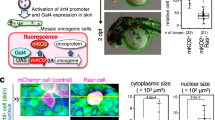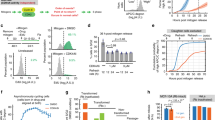Abstract
Cancer cells arise from normal cells through the acquisition of a series of mutations in oncogenes and tumour suppressor genes1. Mouse models of human cancer often rely on germline alterations that activate or inactivate genes of interest. One limitation of this approach is that germline mutations might have effects other than somatic mutations, owing to developmental compensation2,3. To model sporadic cancers associated with inactivation of the retinoblastoma (RB) tumour suppressor gene in humans, we have produced a conditional allele of the mouse Rb gene. We show here that acute loss of Rb in primary quiescent cells is sufficient for cell cycle entry and has phenotypic consequences different from germline loss of Rb function. This difference is explained in part by functional compensation by the Rb-related gene p107. We also show that acute loss of Rb in senescent cells leads to reversal of the cellular senescence programme. Thus, the use of conditional knockout strategies might refine our understanding of gene function and help to model human cancer more accurately.
This is a preview of subscription content, access via your institution
Access options
Subscribe to this journal
Receive 51 print issues and online access
$199.00 per year
only $3.90 per issue
Buy this article
- Purchase on Springer Link
- Instant access to full article PDF
Prices may be subject to local taxes which are calculated during checkout



Similar content being viewed by others
References
Hanahan, D. & Weinberg, R. A. The hallmarks of cancer. Cell 100, 57–70 (2000)
Van Dyke, T. & Jacks, T. Cancer modelling in the modern era: Progress and challenges. Cell 108, 135–144 (2002)
Jonkers, J. & Berns, A. Conditional mouse models of sporadic cancer. Nature Rev. Cancer 2, 251–265 (2002)
Sage, J. et al. Targeted disruption of the three Rb-related genes leads to loss of G1 control and immortalization. Genes Dev. 14, 3037–3050 (2000)
MacPherson, D. et al. Conditional mutation of Rb causes cell cycle defects without apoptosis in the central nervous system. Mol. Cell. Biol. 23, 1044–1053 (2003)
Hurford, R. K. Jr, Cobrinik, D., Lee, M. H. & Dyson, N. pRB and p107/p130 are required for the regulated expression of different sets of E2F responsive genes. Genes Dev. 11, 1447–1463 (1997)
Lomazzi, M., Moroni, M. C., Jensen, M. R., Frittoli, E. & Helin, K. Suppression of the p53- or pRB-mediated G1 checkpoint is required for E2F-induced S-phase entry. Nature Genet. 31, 190–194 (2002)
Trimarchi, J. M. & Lees, J. A. Sibling rivalry in the E2F family. Nature Rev. Mol. Cell Biol. 3, 11–20 (2002)
Rubinson, D. A. et al. A lentivirus-based system to functionally silence genes in primary mammalian cells, stem cells and transgenic mice by RNA interference. Nature Genet. 33, 401–406 (2003)
Hayflick, L. & Moorhead, P. S. The serial cultivation of human diploid cell strains. Exp. Cell Res. 25, 585–621 (1961)
Campisi, J. Cellular senescence as a tumour-suppressor mechanism. Trends Cell Biol. 11, S27–S31 (2001)
Schmitt, C. A. et al. A senescence program controlled by p53 and p16INK4a contributes to the outcome of cancer therapy. Cell 109, 335–346 (2002)
Dannenberg, J. H., van Rossum, A., Schuijff, L. & te Riele, H. Ablation of the retinoblastoma gene family deregulates G1 control causing immortalization and increased cell turnover under growth-restricting conditions. Genes Dev. 14, 3051–3064 (2000)
Carneiro, C. et al. p27 deficiency desensitizes Rb-/- cells to signals that trigger apoptosis during pituitary tumour development. Oncogene 22, 361–369 (2003)
Classon, M. & Harlow, E. The retinoblastoma tumour suppressor in development and cancer. Nature Rev. Cancer 2, 910–917 (2002)
Todaro, G. & Green, H. Quantitative studies of the growth of mouse embryo cells in culture and their development into established lines. J. Cell Biol. 17, 299–313 (1963)
Serrano, M., Lin, A. W., McCurrach, M. E., Beach, D. & Lowe, S. W. Oncogenic ras provokes premature cell senescence associated with accumulation of p53 and p16INK4a. Cell 88, 593–602 (1997)
Jat, P. S. & Sharp, P. A. Cell lines established by a temperature-sensitive simian virus 40 large-T-antigen gene are growth restricted at the nonpermissive temperature. Mol. Cell. Biol. 9, 1672–1681 (1989)
Gire, V. & Wynford-Thomas, D. Reinitiation of DNA synthesis and cell division in senescent human fibroblasts by microinjection of anti-p53 antibodies. Mol. Cell. Biol. 18, 1611–1621 (1998)
Pfeifer, A., Brandon, E. P., Kootstra, N., Gage, F. H. & Verma, I. M. Delivery of the Cre recombinase by a self-deleting lentiviral vector: Efficient gene targeting in vivo. Proc. Natl Acad. Sci. USA 98, 11450–11455 (2001)
Dirac, A. M. & Bernards, R. Reversal of senescence in mouse fibroblasts through lentiviral suppression of p53. J. Biol. Chem. 278, 11731–11734 (2003)
Vooijs, M., van der Valk, M., te Riele, H. & Berns, A. Flp-mediated tissue-specific inactivation of the retinoblastoma tumour suppressor gene in the mouse. Oncogene 17, 1–12 (1998)
Marino, S., Vooijs, M., van Der Gulden, H., Jonkers, J. & Berns, A. Induction of medulloblastomas in p53-null mutant mice by somatic inactivation of Rb in the external granular layer cells of the cerebellum. Genes Dev. 14, 994–1004 (2000)
Brummelkamp, T. R., Bernards, R. & Agami, R. A system for stable expression of short interfering RNAs in mammalian cells. Science 296, 550–553 (2002)
Acknowledgements
We thank R. Jaenisch, S. Lowe and B. Kennedy for various useful reagents; D. Tuveson for helpful discussions; A. Brunet, K. Johnson and M. McLaughlin for critical reading of the manuscript; and members of F. Gertler's laboratory for help with the videomicroscopy experiments. This work was supported by funding from the Human Frontier Science Program, the Medical Foundation and the Merck/MIT postdoctoral fellowship program (J.S.), and from the National Cancer Institute and the Howard Hughes Medical Institute (T.J.).
Author information
Authors and Affiliations
Corresponding author
Ethics declarations
Competing interests
The authors declare that they have no competing financial interests.
Rights and permissions
About this article
Cite this article
Sage, J., Miller, A., Pérez-Mancera, P. et al. Acute mutation of retinoblastoma gene function is sufficient for cell cycle re-entry. Nature 424, 223–228 (2003). https://doi.org/10.1038/nature01764
Received:
Accepted:
Issue Date:
DOI: https://doi.org/10.1038/nature01764
This article is cited by
-
Ligand-dependent hedgehog signaling maintains an undifferentiated, malignant osteosarcoma phenotype
Oncogene (2023)
-
Senescence and cancer — role and therapeutic opportunities
Nature Reviews Clinical Oncology (2022)
-
Retinoblastoma tumor cell proliferation is negatively associated with an immune gene expression signature and increased immune cells
Laboratory Investigation (2021)
-
Altered G1 signaling order and commitment point in cells proliferating without CDK4/6 activity
Nature Communications (2020)
-
Opposing effects of acute versus chronic inhibition of p53 on decitabine’s efficacy in myeloid neoplasms
Scientific Reports (2019)
Comments
By submitting a comment you agree to abide by our Terms and Community Guidelines. If you find something abusive or that does not comply with our terms or guidelines please flag it as inappropriate.



